One type of Magic article I personally enjoy quite a lot is the classic “do you mulligan this hand?” questionnaire. For one thing, they teach us a skill we
will definitely need and do so by putting us right on the spot – something that is often hard to achieve in Magic writing simply because of how fluid and
flexible the game is. Secondly, they’re exactly the kind of thing you want to prepare for ahead of time. Taking a long time to make your mulligan decision
is just a waste of valuable round time in a tournament setting, and yet there sometimes are a lot of different elements to take into consideration when
deciding to take a mulligan (or not), making actually reasoning out if something is a keep a rather long-winded process. In those tight cases, having
already considered similar hands back in the calm safety of pre-tournament preparation is valuable tool and time saver.
Imagine then my surprise when I realized that it had been basically forever since I had done something even remotely similar. Today we’re going to rectify
this. To spice things up a little, we’ll be looking at five different decks, a hand each, including some decks I’m not actually intimately familiar with.
That way we not only talk about decks where I’m pretty confident that I know what I’m doing, but that you also get a couple of examples as to how I’d
approach the mulligan process with a deck I’m rather unfamiliar with. Well, enough prelude. The cards are waiting, so let’s get going!
Miracles
Let’s start with something I’m quite comfortable with, the Miracles list I’ve been running since back in January.
Creatures (1)
Planeswalkers (2)
Lands (22)
Spells (35)

It’s game 1 against an unknown opponent, we’ve lost the die roll, and we draw up these seven:

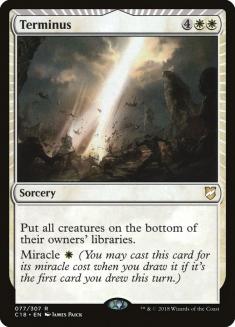
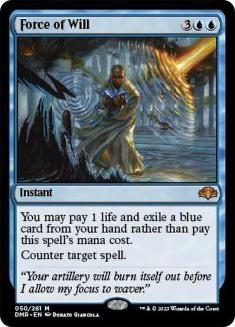
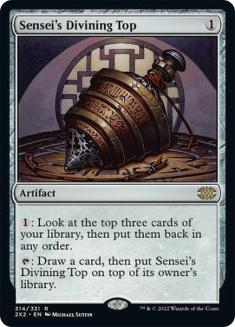
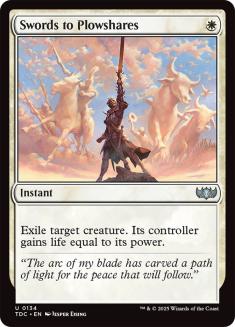
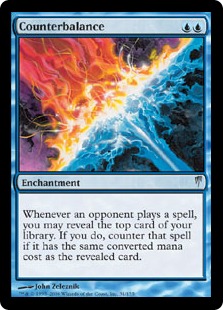
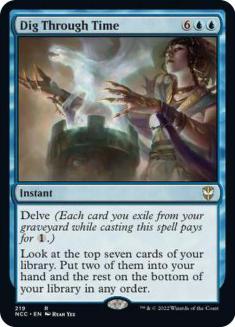

We are on the draw.
This hand is really difficult, in my opinion, because it might be utterly awesome, or a total trap, depending on what we draw and what deck we’re playing
against. There are two obvious things going on with this hand. First, it’s clearly extremely light on lands for a deck like Miracles that really really
doesn’t want to miss land drops. Second, the spells in it are absolutely awesome with the deck’s most important card (Sensei’s Divining Top) and the
Counterbalance for the full lock. It also has a Force of Will and a Swords to Plowshares to answer any early threats our opponent might come up with.
So how valuable is that hand? The first thing I tend to look for are holes in my gameplan, cards and plays that are likely to just demolish me. The obvious
one in this case is Wasteland. If our opponent has a Wasteland, we’re likely just dead unless we’re lucky enough to rip a couple of lands of the top
naturally.
Similarly, a Thoughtseize or similar discard effect puts us in a pretty big bind. Our hand is quite reliant on Sensei’s Divining Top to help us make those
land drops even if we don’t get Wastelanded, so we’re basically forced to blow our Force of Will on any turn 1 discard spell – remember we’re on the draw.
And while it’s nice to be reasonably sure that our Top will make it into play, Forcing on turn 1 still represents a pretty high commitment.
Finally it should be noted that this hand is already going to play as a five to six card hand for a while given what we know. The Terminus in our hand is
going to be doing nothing for quite some time given that we don’t have access to a Brainstorm to put it back where we want it, and we’re also unlikely to
be casting that Dig Through Time anytime soon, though it isn’t really a dead card because it’s a convenient way to pay for our Force of Will and not feel
bad about it.
Those are a couple of strong reasons to ship this one. Why would we keep it, then? Well, the one real argument for keeping this one is how powerful it
becomes if we find our second blue source on time. Turn 1 Top into turn 2 Counterbalance to establish the lock with Force of Will backup is nothing to
sneeze at, and we even have Swords to Plowshares to clean up the first threat that might have slipped through the cracks of the lock. That’s a gamestate a lot of decks just won’t recover from in the vast majority of games.
Essentially this is a very high risk, high reward kind of hand. If we hit our land drops, it’s likely awesome and will often run away with the game. If we
don’t or worse, we get Wastelanded, there’s a strong chance we aren’t going to do much of anything this time around. So one big question is how likely we
are to rip a land on turn 1 or 2 without spending mana Topping (so as to give us a shot at turn 2-ing that Counterbalance). Luckily, that one isn’t too
hard to figure out. We have 21 lands remaining in our deck, 18 of which produce blue mana. That’s 18 hits in 53 cards with us getting two shots to find
what we need. That means there’s a 35/53*34/52 or about 43.2% chance that we don’t see a blue land in our first two draw steps (so we are 56.8% to get
there). That’s actually pretty decent given that I think we’ll be hard pressed to lose against most decks that have neither Wasteland nor Daze if that land
turns up (on the play we’d be 66% to miss our second land drop assuming no Top activation, which would make this an easy mulligan to my mind unless I know my opponent is on Storm or something similar).
As a result, our decision is extremely contextual. Against a non-Wasteland deck that’s very weak to the Counter-Top lock (Storm being a prime example), I’d
keep this one in a heartbeat. Against a Delver strategy, on the other hand, I’d snap-mulligan it because Wasteland is such a terrible blow, and fighting
through all their soft-counters will be hell on wheels given our mana situation. Sadly, we don’t have any idea what we’re playing against.
Our decision then is about weighing risks, and the greedy part of me really wants to keep this one just because of the potential if we get there. In the
end though, if put in this spot during a tournament, I’d end up mulliganing this mainly because the land in my hand is a Tundra (unless I know the metagame
well enough to know that there are very few Wastelands around). With an Island, we could at least be reasonably sure that we’ll get to start spinning Top
to help find those missing lands, but given that turn 1 Wasteland will just cold us more than 40% of the time (don’t kid yourself, even if we hit on turn
3, we’re likely not coming back from being on one mana on turn 3 against a Wasteland strategy) is not a risk I’m ready to run in the dark with a deck as
resilient and powerful as Miracles (effectively being on six already – a pretty decent six, mind you – due to the Terminus helping to further justify
shipping this one).
Storm
Well, we had one of my two favorite Legacy decks; time for the other one!
Lands (15)
Spells (45)

Another game 1 against an unknown opponent, though this time we’ve won the die roll:

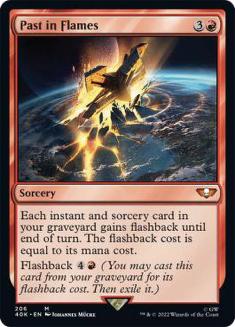
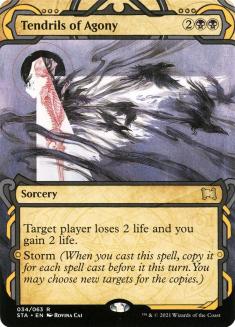
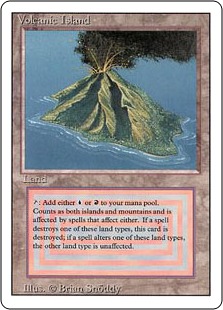
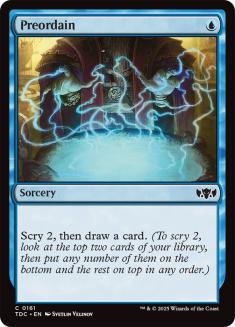
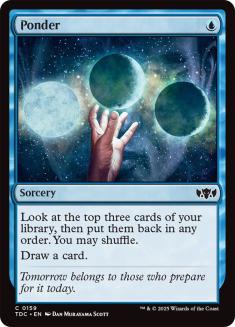


We’re on the play.
Different deck, very similar problem. A hand with awesome sculpting potential but pretty clear mana issues. The answer to what we should be doing is much
more clear cut though: If you aren’t ready to keep these kinds of hands, you shouldn’t be playing Storm.
Why is that? Well, first and foremost, we get to cantrip for another land on turn 1 (I’d actually, unusually, start off with Ponder instead of Preordain
here just to maximize my chance to hit a land before I can be Wastelanded, as I’d likely ship anything that isn’t a land anyway), which I know from
experience has a decent chance of finding that blue land even with only thirteen blue sources remaining in the deck. Second, we don’t know we’re getting
Wastelanded, and if we actually make it to turn 2 with our land intact, the next cantrip is almost guaranteed to get us there.
Combine that with the fact that Storm is quite different from Miracles – any land drop beyond the second is a luxury you might like but don’t actually need – and we have a hand I wouldn’t mulligan for mana reasons in a million years unless I know it’s specifically weak in the matchup at hand
(this is quite the sketcher in the mirror for example, because it is slow and non-disruptive, but I’d even keep it against a known player of Wasteland).
Finally, while Past in Flames and Tendrils of Agony may look sketchy in this hand, and it’s usually mediocre/bad to draw either early, having both
of them means one very important thing: We already have all the business spells we’re likely going to need to finish this game, so all we’re digging for at
this point are mana sources (Rituals and a black land specifically) and maybe a discard spell. In a hand full of cantrips, having very clear cut
requirements of the cards you’re trying to find is quite helpful because, as we all know, the blue cantrips are awesome at retrieving a particular class of
card that’s abundant in our deck – and lands and fast mana are exactly what Storm has the most copies of.
Death and Taxes
From the two decks I’m most intimately familiar with, to one I have only really played in a single decent playtesting session – Legacy’s resident
mono-white prison deck:
Creatures (26)
- 4 Mother of Runes
- 2 Serra Avenger
- 4 Flickerwisp
- 4 Stoneforge Mystic
- 2 Mirran Crusader
- 4 Phyrexian Revoker
- 4 Thalia, Guardian of Thraben
- 1 Brimaz, King of Oreskos
- 1 Spirit of the Labyrinth
Lands (23)
Spells (11)

As with every time, let’s assume a game 1 situation against an unknown opponent:
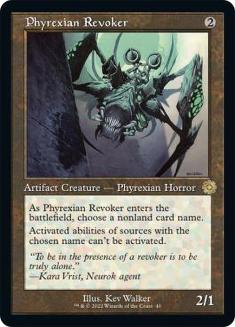
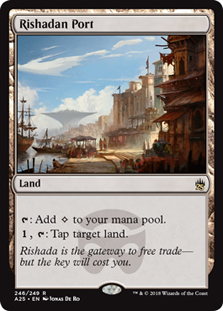
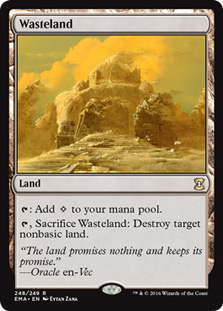
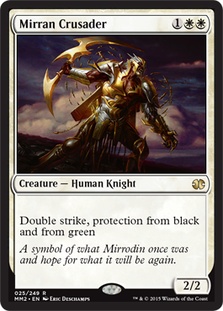


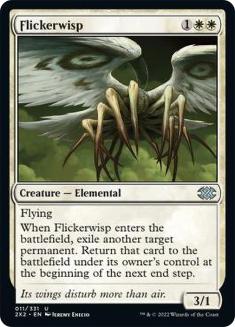

We’re on the draw.
Well, on first sight this one seems rather sketchy seeing as how we can only cast a single one of our spells, a rather anemic 2/1 for two. If Death and
Taxes was an actual White Weenie deck, that would probably be a death knell in and of itself.
However, I still can’t imagine that you’re supposed to ever mulligan this in Death and Taxes given that it is not a White Weenie deck in spite of
the small white guys and gals (and animals, and robots) present in the decklist. The mana denial angle of Wasteland and Rishadan Port is such a big part of
the deck’s gameplan as I understand it that I can only assume this is actually a great hand in the dark (in contrast it’s likely pretty bad if we know our
opponent is on Miracles and will laugh at our Wasteland).
We have fourteen lands to draw into that will let us cast Flickerwisp or Mirran Crusader (with Cavern of Souls making us choose which one) and all the mana
denial we could want to buy time until we actually do draw that second source of white mana.
Yes, we’re very weak to Delver of Secrets (unless we topdeck a Swords to Plowshares), and if our opponent insists on just playing fetchlands and passing
the turn, things will fall apart rather rapidly, but this hand perfectly executes the deck’s primary mana denial gameplan and is only a single land away
from being fully active. And while I’m not intimately familiar with Death and Taxes, I have enough experience with Wasteland the card that I know you
should always strongly consider keeping any remotely functional hand that has two copies of the Tempest uncommon simply because of how many games there are
where losing their first two lands leaves the opponent completely crippled.
Temur Delver
Well, no Legacy article is really complete without referencing the insect menace, is it?
Creatures (12)
Lands (18)
Spells (30)

Game 1, unknown opponent, you know the drill by now.
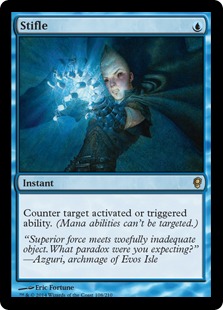
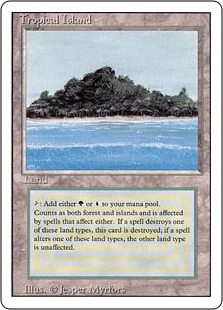
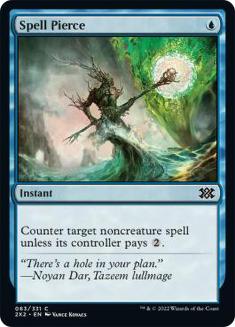


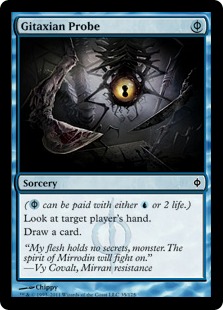


How lucky. We’re on the play.
This hand isn’t interesting because I’d really consider mulliganing it – I think it has too much potential to throw away – but because I think it’s much
closer than most people realize. On first sight, this hand is awesome. We have early disruption in Stifle and Spell Pierce to mess with our opponent (one
of our two primary goals with Temur Delver), Gitaxian Probe to help us place our disruption perfectly, and multiple cantrips to help us fix what’s wrong
with this hand.
So what is actually wrong with this hand? Well, it’s missing two key pieces to what we’re attempting to do. First, we have a Lightning Bolt stranded in our
hand until we can find a red source of mana, meaning there are actually a number of problematic turn 1 plays we can’t do much about as things stand,
Deathrite Shaman foremost among them.
Most importantly, though, we don’t have any kind of threat. Temur Delver more than any other Delver deck (other than maybe the U/R and Grixis variants that
have grown out of the Treasure Cruise era) relies on having access to an early threat. The deck doesn’t plan to use its disruption to truly control the
game but only to buy turns for its threats to take the opponent out while you keep them stumbling. As such, any hand without a threat is already
fundamentally flawed to a certain extent.
In this particular case, the situation is made worse by the fact that both of our cantrips happen to be Brainstorms while we don’t have a shuffle effect
available. If our first Brainstorm misses the second land or the threat we’re looking for (or, worst of all, both), the second one will be of only marginal
utility in helping us fix those issues in a timely manner.
All that being said, this hand sees enough additional cards that I can’t really imagine a situation in which I would ship this, though I think it’s
actually a comparatively marginal hand in contrast to how good it looks on first sight.
Dredge
And to round things out, a look at the deck with some of the weirdest mulligan patterns in the game. Note that this list is taking a more risky approach to
Dredge than more common set ups involving Putrid Imp, cutting the consistent discard outlet to make room for a maximum number of dredgers and actual draw
spells to give the deck as much aggressive combo potential as possible (Berlin is still full of Storm and Miracles).
Creatures (21)
- 3 Ichorid
- 1 Flame-Kin Zealot
- 4 Golgari Grave-Troll
- 4 Golgari Thug
- 4 Stinkweed Imp
- 4 Narcomoeba
- 1 Griselbrand
Lands (13)
Spells (26)

And once more with feeling, same conditions as last time Miss Sophie:
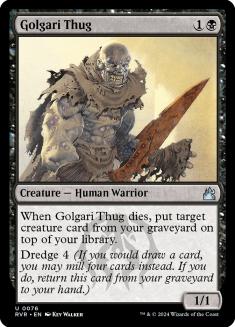
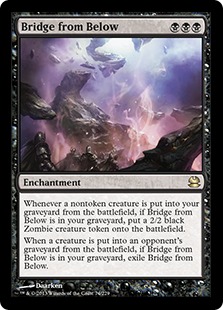
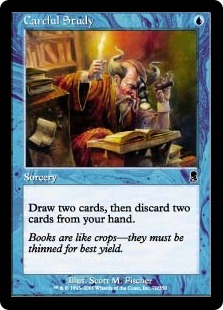
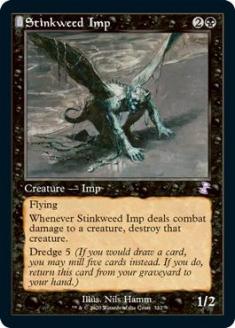
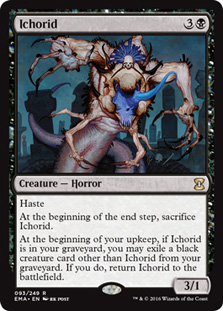
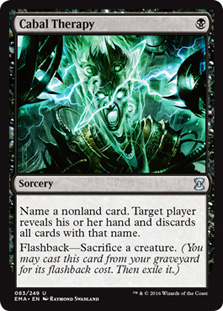
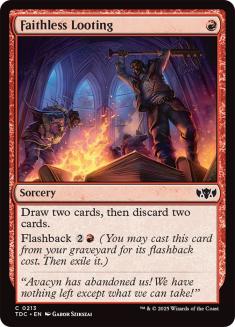

We’re on the draw.
No lands means mulligan, right? Well, not so fast–this is Dredge after all, and we’re on the draw with dredgers in hand. That means that we have at the
very least the option to play the game like Manaless Dredge would, DDDing (Draw, Discard, Dredge) every turn and relying on our opponent’s inability to
actually interact with our gameplan to give us the edge in that scenario.
We also have a 9/53 (or roughly 17%) chance to draw a five-color land on turn 1 and turn this hand into the total nuts, and 13/53 (~24.5%) to hit a gold
land or Cephalid Coliseum to enable at least Careful Study either on turn 1 (the risky move since we’d need to either hit a land, an LED, or another blue
draw spell to make that a solid play) or on turn 2 after DDDing (awesome if we flip over more dredgers to allow us to dredge the Careful Study draws). LED
is another out towards doing something more powerful than the natural dredge chain, as that’d allow us to Flashback Faithless Looting with our dredger
already in the yard on turn 1. That puts us at 13/57 (32%) to draw something on turn 1 that makes this hand do something actually busted. If we are ready
to choose to draw on turn 2 instead of dredging after missing on turn 1, that gives us a 48.7% chance (1-13/53*13/52) to find something that allows us to
go broken. If neither of those shots materializes, we’re likely stuck with the DDD plan.
Given that we’re less than fifty percent to do something broken on turn 2, the real question we need to answer for ourselves is how often the DDD plan is
going to be good enough to get us there. Sadly, that’s decided mainly by information we don’t have yet: what our opponent is playing and how good their
hand is. If they’re on some kind of slow and ponderous control or prison deck, or even a Delver deck with a weak draw (like the one we discussed above),
DDD is usually a realistic plan to go for. Against turn 1 Delver of Secrets or any kind of combo deck (or even just Mountain, Lightning Bolt you for that
matter), on the other hand, DDD has a strong chance of being too slow to matter, especially given our hand and how the deck is configured (only three
Ichorids, with one stuck in hand alongside a Bridge from Below). Deathrite Shaman also is absolutely devastating to that plan.
Now, I believe in aggressively mulliganing with Dredge, especially a list as all-in as this one, particularly in game 1. You see, much of the strength of
Dredge stems from its game 1 win percentage when opponents don’t yet have access to graveyard hate, and therefore, can’t keep up if the engine ever starts
humming. As such, we really want to make sure we can take that game 1 we’re supposed to get, as otherwise our overall win percentage goes straight down the
drain given the power level of graveyard hate at this point.
What that boils down to is this: I might keep this hand against a known opponent who I can be reasonably sure will give me the time to win by DDDing – some
ponderous control deck – but I’d mulligan this in the dark against an unknown opponent. If we keep, we have our 25% chance to do something powerful plus
whatever the chance is to win by DDD. That’s decent if DDD has a decent chance to get there, but it’s pretty atrocious otherwise, even given our ability to
try and hit with our turn 2 draw step (we’d still be below 50% to win if the matchup requires us to do something broken).
The factor then that makes me want to mulligan this hand is simply the strength of Dredge’s mulligans. It’s reasonably easy to win early and overpower
opponents even with five-card hands in the deck, and even going to four is not necessarily a disaster (you are, after all, mainly looking for three exact
pieces: a dredger, a draw spell, and the mana to cast said draw spell; your hand really doesn’t matter once you’ve started the engine, meaning there
usually are a couple of pointless cards in there anyway).
Take all of this with a grain of salt, though. I’m far from a Dredge expert, and if someone among you with deep experience with the deck thinks that hand
is a keep in the dark, I’d love to hear their reasoning to understand where I’m going wrong.
Mulling Things Over
Five decks, five hands, lots of thoughts. Mulliganing is a skill that is rewarded much more strongly in the Eternal formats than in any other just because
of the compressed the games usually are and how much focus there is on having a solid earlygame as a result. I hope today’s offering helped clarify the
thought processes that go into figuring out some of the closer hands you’re likely to see when sitting down for a Legacy match and also served as a decent
first step in illustrating how differently various archetypes have to treat their opening sevens. If nothing else, I’ve hopefully at least proven the value
of thinking things through ahead of time so you don’t have to do so while under the full time pressure of an active round. After all, the mulligan is often
the most important decision you’ll have in a game of Magic, possibly dooming you before the first card has even been played – make sure you do it
correctly!
And next week on this same channel, episode three of You Choose The Brew 2015 edition. In last week’s outing, a pretty clear majority
among you have chosen to commit us to biological warfare, with 41.6% of you casting their votes for the Loam Pox archetype. Tune in next week to see how my
first attempts in that direction turn out!
